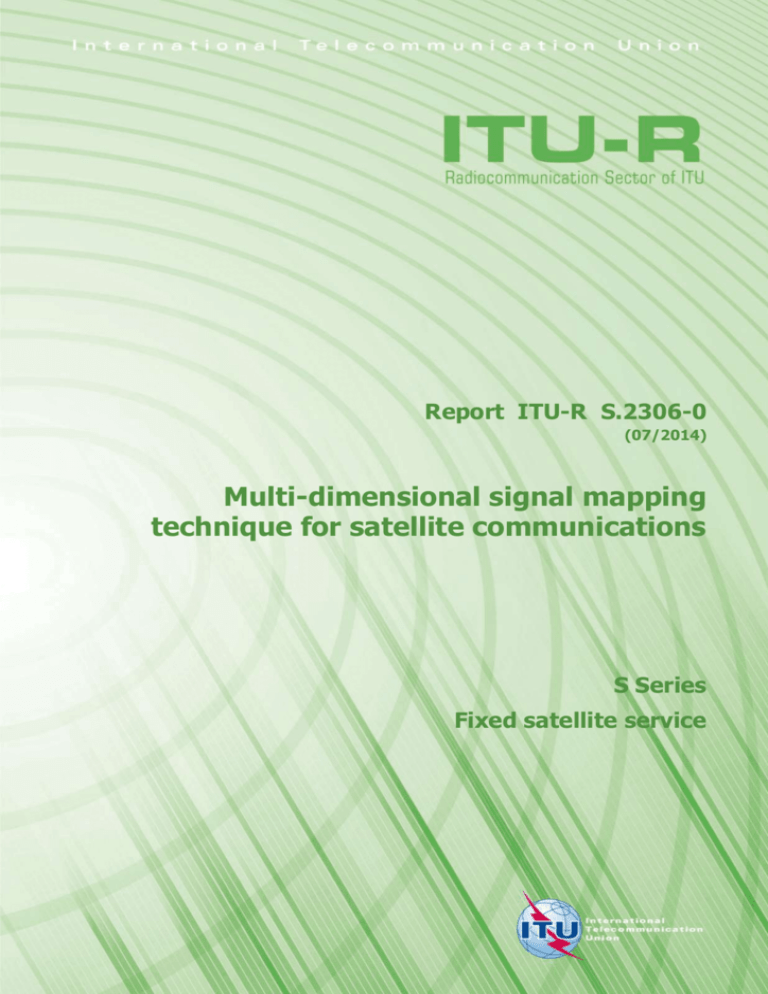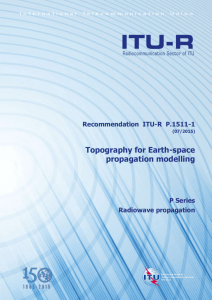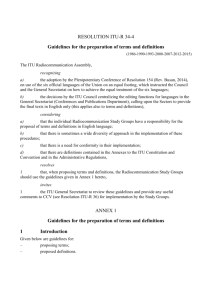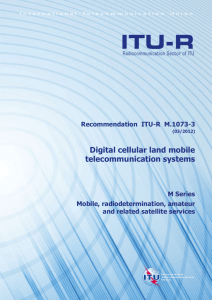
Report ITU-R S.2306-0
(07/2014)
Multi-dimensional signal mapping
technique for satellite communications
S Series
Fixed satellite service
ii
Rep. ITU-R S.2306-0
Foreword
The role of the Radiocommunication Sector is to ensure the rational, equitable, efficient and economical use of the
radio-frequency spectrum by all radiocommunication services, including satellite services, and carry out studies without
limit of frequency range on the basis of which Recommendations are adopted.
The regulatory and policy functions of the Radiocommunication Sector are performed by World and Regional
Radiocommunication Conferences and Radiocommunication Assemblies supported by Study Groups.
Policy on Intellectual Property Right (IPR)
ITU-R policy on IPR is described in the Common Patent Policy for ITU-T/ITU-R/ISO/IEC referenced in Annex 1 of
Resolution ITU-R 1. Forms to be used for the submission of patent statements and licensing declarations by patent
holders are available from http://www.itu.int/ITU-R/go/patents/en where the Guidelines for Implementation of the
Common Patent Policy for ITU-T/ITU-R/ISO/IEC and the ITU-R patent information database can also be found.
Series of ITU-R Reports
(Also available online at http://www.itu.int/publ/R-REP/en)
Series
BO
BR
BS
BT
F
M
P
RA
RS
S
SA
SF
SM
Title
Satellite delivery
Recording for production, archival and play-out; film for television
Broadcasting service (sound)
Broadcasting service (television)
Fixed service
Mobile, radiodetermination, amateur and related satellite services
Radiowave propagation
Radio astronomy
Remote sensing systems
Fixed-satellite service
Space applications and meteorology
Frequency sharing and coordination between fixed-satellite and fixed service systems
Spectrum management
Note: This ITU-R Report was approved in English by the Study Group under the procedure detailed in
Resolution ITU-R 1.
Electronic Publication
Geneva, 2014
ITU 2014
All rights reserved. No part of this publication may be reproduced, by any means whatsoever, without written permission of ITU.
Rep. ITU-R S.2306-0
1
REPORT ITU-R S.2306-0
Multi-dimensional signal mapping technique for satellite communications
(Question ITU-R 46-3/4)
(2014)
1
Introduction
This Report proposes two techniques to increase the spectrum efficiency of satellite
communications. The techniques differ from the conventional orthogonal polarization multiplexing
(OPM) scheme such as the one shown in Report ITU-R M.2175 [1], by multiplexing/modulating
more than two data streams onto the vertical (V) and horizontal (H) polarizations.
The Report shows that the total transmit power can be reduced by up to about 2.3 dB at BER 10–4
and maintain the same spectral efficiency as OPM. The proposed schemes are flexible in that they
can be applied to many different modulation formats and spectrum configurations. The particular
scheme can be selected based on the required spectral efficiency and operating SNR region. The
concepts of the two schemes are first described, then, the spectrum usage and the results of a
computer simulation, indoor laboratory and actual satellite measurements are revealed.
2
Concept of multi-dimensional signal mapping
Two types of multi-dimensional signal mapping are described. The first technique is termed
poly-polarization multiplexing (PPM) and the second scheme is termed polarization domain
modulation (PDM).
2.1
Poly-Polarization Multiplexing (PPM)
Figure 1 shows the basic concept of the proposed PPM scheme [2-4]. Input data is split into M data
streams and each data stream is allocated to a certain polarization plane whose angle is different
from all others. In the case of three data streams (termed ʻ3PMʼ), the 3rd data stream is at a
polarization angle half-way between that of the V and H axis. The projection of its vertical (V) and
horizontal (H) component signals is then made onto the two physical V and H channels
respectively. When superposed signals of projected components are transmitted from V and H
polarization antennas, the virtual additional polarization planes can be recovered. The transmitted
signals, SH(t) and SV(t) on H and V polarization antennas shown in Fig. 1 are expressed by (1).
𝑀
cos φ𝑚
𝑆 (𝑡)
[ 𝐻 ] = ∑ (𝐴𝑚 [ sin φ ] 𝑃𝑚 (𝑡))
𝑆𝑉 (𝑡)
𝑚
(1)
𝑚=1
where:
M:
m:
number of polarizations multiplexed
polarization index
Am, m and Pm: amplitude, polarization angle and modulated signal of m-th virtual
polarization plane, respectively.
Note that equation (1) is a case that all virtual polarization signals are projected onto V and H
polarizations in-phase.
2
Rep. ITU-R S.2306-0
FIGURE 1
Concept of poly-polarization multiplexing (PPM)
Meanwhile, when each virtual polarization signal is projected onto an arbitrary phase, equation (1)
can be rewritten as equation (2).
𝑀
α𝑚
𝑆 (𝑡)
[ 𝐻 ] = ∑ ([β ] 𝑃𝑚 (𝑡))
𝑆𝑉 (𝑡)
𝑚
(2)
𝑚=1
where αm and βm are complex coefficients. Equation (2) gives a general formula of the proposed
PPM transmitter as shown in Fig. 2(a).
FIGURE 2
(a) PPM transmitter, (b) PPM receiver
The estimated symbol Pm(t) at the receiver is calculated from RH(t), RV(t) using maximum
likelihood detection (MLD) (see Fig. 2(b)) as per equation (3).
2
2
𝑃̃𝑚 (𝑡) = arg min ‖𝑅𝐻 (𝑡) − 𝑅̃𝐻 (𝑛)‖ + ‖𝑅𝑉 (𝑡) − 𝑅̃𝑉 (𝑛)‖
(3)
1≤𝑛≤2𝑁
α𝑚
𝑅̃ (𝑛)
[ 𝐻 ] = ∑𝑀
𝑚=1 ([β ] 𝑋𝑚 (𝑛))
̃
𝑚
𝑅𝑉 (𝑛)
where:
n:
N:
𝑋𝑚 (𝑛):
candidate symbol index on the H and V planes
number of bits per symbol
n-th candidate symbol and the received signal is given by equation (4).
(4)
Rep. ITU-R S.2306-0
3
An optimum coefficient set, αm and βm, was searched by using the generalized reduced gradient
(GRG) algorithm. The search range was [1 ≤ α ≤ 1] and [1 ≤ β ≤ 1] and proceeded in steps of
0.00001. The optimized set had a minimum Euclidean distance (Dmin) of 0.7071 and compares with
0.5412 for OPM-8PSK (see Table 1). This increase in Dmin is the reason for the improved BER
performance. The I-Q constellation points for the proposed scheme are shown in Fig. 3.
TABLE 1
Minimum Euclidean Distance (6 bit/symbol)
Signal set
Streams
Minimum Euclidean distance (Dmin)
OPM (8PSKx2)
2 (H/V)
0.5412
3
0.7071
PPM
FIGURE 3
Composite constellations diagram (a) Vi-Vq-Hi, (b) Hi-Hq-Vq
2.2
Polarization Domain Modulation (PDM)
The PDM transmitter converts the input data into parallel streams and maps a component of each
signal onto orthogonal streams. An extra information stream is transmitted by controlling the
polarization phase and a general constellation is shown in Fig. 4(a). The modulation scheme is
referred to as SP-BQAM where S indicates the number of polarization states and B is the
modulation level. A simple case of 2P-4QAM (S = 2 and B = 4) is used to explain the concept as
shown in Fig. 4(b). The polarization angle in 2P-4QAM is ±45 degrees and candidate signal points
for different polarization angles are also shown. The combination of the I-Q data points and the
polarization phase conveys the information.
4
Rep. ITU-R S.2306-0
FIGURE 4
(a) General PDM V-H constellation, (b) 2P-4QAM image
The polarization angle is the angle relative to the H plane. At any one instance in time only one
symbol is transmitted and in the case of 2P-4QAM, eight candidate I-Q points convey three data
bits {i.e. log2(S) + log2(B)} (see Fig. 4(b)). The PDM transmitter is shown in Fig. 5. The serial
input data is converted into parallel streams and mapped onto the H and V planes according to
equations (5a) and (5b).
𝑆𝐻 (𝑡) = 𝐼𝑏 (𝑡) cos(θ𝑠 (𝑡)) + 𝑗𝑄𝑏 (𝑡) cos(θs (𝑡))
(5a)
𝑆𝑉 (𝑡) = 𝐼𝑏 (𝑡) sin(θs (𝑡)) + 𝑗𝑄𝑏 (𝑡) sin(θs (𝑡))
(5b)
where:
θ𝑠 (𝑡):
𝐼𝑏 (𝑡) + j𝑄𝑏 (𝑡):
polarization angle relative to the H plane
modulator output at time t.
FIGURE 5
PDM transmitter
The receiver for the PDM scheme uses the same MLD [5] function shown in Fig. 2(b) and
described by equation (3), but requires the PDM candidate signals for the reference signal set to
calculate the Euclidean distance.
Rep. ITU-R S.2306-0
3
5
Spectrum usage
Figure 6 shows an overview of the spectrum usage of the proposed multiplexing scheme.
Figure 6(a) shows the concept where the signals are mapped onto both V and H polarizations in the
same spectrum band. Figure 6(b) shows the configuration where the V and H planes are staggered
and Fig. 6(c) shows an alternative format where the two signal components are transmitted on the
same polarization but different centre frequencies. In all cases the spectrum shape and bandwidths
are the same. Clearly, it is not possible to form virtual polarization planes with configurations (b)
and (c), however, the pairs of signals can be used to convey the transmitted information as in (a).
This means the scheme is compatible with a range of other frequency division multiple access
(FDMA) based schemes.
FIGURE 6
(a) Same spectral shape, (b) Staggered centre frequency, (c) Different frequency same polarization
4
Performance evaluation
A software simulation was conducted to compare the performance of the proposed schemes with
that of a comparable conventional OPM system achieving the same spectral efficiency
(see Table 2). The results were also compared with those from actual hardware measurements in an
indoor trials campaign. The system parameters are shown in Table 3. The hardware measurement
results naturally include an arbitrary timing offset due to the random start-up state.
For PPM, the performance is compared to an OPM one with two streams of 8PSK, which achieves
a total of 6 bit/s/Hz efficiency. In the case of PDM, it is compared with an OPM scheme consisting
of QPSK on V and BPSK on H achieving 3 bit/s/Hz efficiency. In each case, the total transmission
power was set at the same value.
The BER results show that the proposed PPM scheme reduces the required SNR by about 1.6 dB at
the BER of 10–4 compared to the conventional OPM scheme. The results are independent of
frequency offsets (see Fig. 7(a)) or phase offsets (see Fig. 7(b)). The small difference between the
simulation and hardware results is attributed to the initial timing synchronization algorithm.
Similarly, the proposed PDM scheme provides an SNR gain of 2.3 dB at the BER of 10–4
(see Fig. 8).
Actual satellite field experiments were additionally conducted in the 14/12 GHz band. The results
of the software simulation (subscript ʻSimʼ), laboratory (subscript ʻLaboʼ) and satellite (subscript
ʻSatʼ) are compared in Fig. 9 for both PPM (6-bit) and PDM (3-bit). It can be seen that the satellite
results closely follow those of the indoor laboratory results showing that the technique works in a
practical satellite channel.
6
Rep. ITU-R S.2306-0
TABLE 2
Modulation overview
Polarization
Scheme
OPM
(8PSKx2)
PPM
OPM
PDM
3PM
(QPSK+BPSK)
2P-4QAM
Number of
streams
2
3
2
3
Stream
modulation
8PSK
(3-bit)
QPSK (2-bit)
QPSK (2-bit)
BPSK (1-bit)
2P-4QAM
Spectral
efficiency
(bit/s/Hz)
6 (3-bit by
2 streams)
6 (2-bit by
3 streams)
3
3
TABLE 3
System parameters
Parameter
Value
Symbol rate
1.6 MBaud
Data length
2 304 symbol/frame
UW length
256 symbol/frame
Roll-off factor
0.2
Detection
MLD
FIGURE 7
BER performances – 3PM (a) Frequency offsets, (b) Phase offsets
Rep. ITU-R S.2306-0
FIGURE 8
BER performances – PDM (a) Frequency offsets, (b) Phase offsets
FIGURE 9
Comparison of simulation, laboratory and satellite experiments
for both PPM (6-bit) and PDM (3-bit)
7
8
5
Rep. ITU-R S.2306-0
Conclusion
This Report proposes the PPM and PDM schemes that reduce the required transmit power by about
1.6-2.3 dB, respectively, compared to the OPM scheme for the same spectral efficiency. The
proposed techniques were tested and verified in both the laboratory and over a real satellite channel.
The choice of scheme depends on the required operating SNR region.
References
[1]
Report ITU-R M.2175 – Simultaneous Dual Linear Polarization Transmission Technique using
Digital Cross-polarization Cancellation for MSS systems, July 2010.
[2]
K. Kobayashi, T. Oka, N. Nakamoto, K. Yano and H. Ban, Poly-polarization Multiplexing Scheme
for Satellite Communications, 30th AIAA International Communications Satellite Systems
Conference (ICSSC) 2012, Sept. 2012.
[3]
M. Yofune, J. Webber, K. Yano, H. Ban, and K. Kobayashi, Optimization of signal design for polypolarization multiplexing in satellite communications, IEEE Communications Letters, Oct. 2013.
[4]
J. Webber, M. Yofune, K. Yano, H. Ban, and K. Kobayashi, Experimental evaluation of a
poly-polarization multiplexing system with timing/frequency recovery for satellite communications,
International Communications Satellite Systems Conference (ICSSC), Florence, Italy, 14-17th Oct.
2013.
[5]
A. van Zelst, R. van Nee, and G. A. Awater, Space Division Multiplexing (SDM) for OFDM
systems, 51st IEEE Vehicular Technology Conference (VTC) 2000-Spring Proceedings, Vol. 2,
pp. 1070-1074, May 2000.









